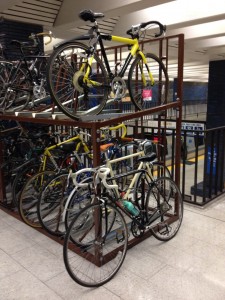“We want to really make sure there is space on BART for everyone, and in particular for those who are disabled who are boarding with a wheelchair or are visually impaired.”
Rivera says the transit agency has even reconfigured many cars in the intervening months. Windscreens near the doors can cause problems, making it harder for bikers to get on without bumping into other customers. So the agency is taking them out and putting in signage to label bike areas.
The move to try out all-hours bikes is welcome by many who use them to commute. At the 19th street BART station in Oakland, Caroline Parsons pushed her bike through the fare gates. She says sometimes the hours she has to work mean she can’t use her bicycle on her commute to a job near the Marina district.
“When I go during no-bike-on-BART hours, it takes me an hour-and-a-half,” says Parsons. “Otherwise it takes me 45 minutes. So that’s really good news.”
But Christine Schindewolf, another daily commuter, says the pilot could be challenging.
“If everyone works together that will be great. But there’s not usually a lot of collaboration on BART, as far as people riding it, because it’s so crowded already. So with the bikes … very challenging.”
BART will be relying on bicyclists to follow the rule that no bikes are allowed on crowded trains, waiting instead for one with more room. Those are the kind of courtesy rules that are used on the New York subways , which allows bikes at all times. The metro train systems in Washington, D.C. and Boston currently have rush hour blackout periods.
The East Bay Bicycle Coalition’s Rivera says feedback sent to BART will be critical during the trial period. She says while the majority of comments in August were positive, about a third were negative. She hopes the negative opinions will be negligible this time around.
“Of course not everybody is going to be happy, but we want it to make the vast majority of people happy with their ride on BART,” says Rivera, who sees a lot of
Rivera says this isn’t just about commuters going to and from San Francisco.
“I really see the people benefiting are those who commute within the East Bay,” she says. “So someone who is going from Pleasanton to Fremont, from Pleasant Hill to Emeryville, so that’s using some unused capacity for BART.” Some of those stations don’t have the kind of density and bus access that San Francisco offers to get people to their final destinations.
BART spokesperson Alicia Trost says the system is considering a lot of options to make bicycles on BART work as smoothly as possible.
“We actually have figures of how many people ride which trains,” says Trost. If commuters put that information into an online trip planner, she says, “you can see the 7:05 trains [has] significantly less riders than the 7:15 train, so maybe bikes can then target that train that has less riders.”
Trost says the system is also committed to adding more bike racks and security cameras near them, “so there are more options for leaving your bikes near the station. That’s obviously the easiest for everyone but we also realize bikes are getting stolen."
BART will be soliciting rider comments after the trial week in March.
